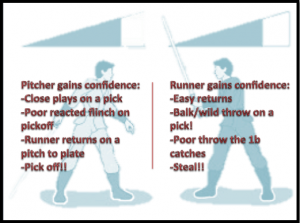Setting Up a Lefty – Part 2
Playing the Game Within the Game
By Matt Talarico, StealBases.com
For part 2 of my “stealing vs. left-handed pitchers” series we will discuss what I like to call the game within the game. Once you have determined the type of left-handed pitcher we’re dealing with (SETTING UP A LEFTY – PART 1) you will then enter the phase of actually setting this pitcher up to steal on. For us, and any aggressive base stealing player/team, this is definitely a plan to actually run… shutting down is not an option. With this said, we don’t just want to go out there and make outs either.
As previously discussed in “part 1” we have put in work to see what options the pitcher will use to stop us from advancing. To do this we have performed fakes but not enough to get us in trouble… use the LEAST effective dose to determine the pitcher’s skill set. This is actually what inspired my original tweet that sparked this blog…
The runner from this tweet simply uses his arm swing to draw pickoffs to get an easy return. That is the goal… every single return needs to be easy, and I mean easy.
For every easy return, balk drawn, error from the pitcher, or steal our strength increases, for every pickoff/close play the pitchers strength increases, much like a video game.

This can go on through the entire time that pitcher is out there… if we get lucky we can even carry that momentum to other pitchers on the team who will eventually step on the mound too. Even if the lefty has a great move, if you get enough easy returns he will begin to question why everyone is seeing it so well. Too often base runners make the mistake of giving pitchers close plays at first or second base, which will get you more attention. Sometimes you have to make an investment for later or for someone else on your team.
So what if you are the fifth player to reach base and the pitcher has gained a lot of confidence already?
Then it is your role to swing the momentum back. Too often this runner will just quit trying to run or get pickoffs and enter safe mode. One key base stealer can swing the game or the series back in the right direction for the entire team. Just get a few easy returns and try again later (maybe just a few pitches later will work).
Here is a good example:
We started our 2016 season off with 2 pickoffs early in the series… not the way you want to start out with a new team.
We faced a lefty that didn’t have a great move but felt like Andy Petite by the time our center fielder reached first without a runner in front of him. When he gave me his batting gloves I said “Ryan we have to get some easy returns, if you just try to force a stolen base we are going to run into another out.” Ryan put together a really good sequence vs. that specific pitcher. He picked over with two or three moves that were not even close. Ryan then stole later in the inning.

We ended that 4 game series with 17 stolen bases. This one “game within the game” swayed the momentum completely in our favor. Our entire dugout realized they could get back easily and that making an early investment was critical. We scored 33 runs in the four game series – which helps the theory that aggressive, legitimate threats to steal will equal more balls to hit hard, which will equal more runs!
Check back soon for part 3 of the “setting up a lefty” series.
To learn how to build your base stealing arsenal sign up today. See all of the details here – sign up here!.
Like us on Facebook at @stealbases or on follow us on twitter at @StealBasesCom for more information.

